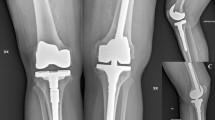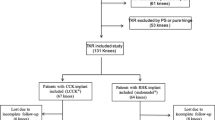Abstract
The aim of this study was to evaluate whether there are any differences in patient-reported outcome measures between semi-constrained condylar constrained knee (CCK) and fully constrained rotating hinge knee (RHK) prostheses in midterm follow-up. We reviewed prospectively collected data of our hospital arthroplasty registry between 2007 and 2014. Thirty-nine patients were identified to have RHK prosthesis TKA and matched for a number of primary/revision TKA, gender, age, body mass index and pre-operative clinical scores to a control group of 78 patients with CCK TKA. Patient demographics, range of movement, varus/valgus deformity, Short Form 36 (SF-36) scores, Oxford Knee Score (OKS), Knee Society Score (KSS) and patient satisfaction were evaluated. Pre-operatively, the RHK and the control group of CCK had similar demographics, proportion of primary/revision TKA and baseline clinical scores (p > 0.05). At 2-year follow-up, patients with CCK prostheses had significantly better clinical outcomes as compared to patients with RHK prosthesis in terms of KSS functional scores, OKS, SF-36 sub-domains of physical functioning, physical role functioning and physical component score. We conclude that at midterm follow-up of 2 years, the CCK patients as compared to RHK patients reported better clinical and functional outcomes in terms of OKS, KSS functional score and SF-36 with a greater proportion of patients who were satisfied and had their expectations met by surgery. Further biomechanical studies are needed to investigate the association between component constraint and clinical outcomes for these prostheses.
Similar content being viewed by others
References
Malcolm TL, Bederman SS, Schwarzkopf R (2016) Outcomes of varus valgus constrained versus rotating-hinge implants in total knee arthroplasty. Orthopedics 39(1):e140–e148. https://doi.org/10.3928/01477447-20151228-07
Morgan H, Battista V, Leopold SS (2005) Constraint in primary total knee arthroplasty. J Am Acad Orthop Surg 13:515–524
Vasso M, Beaufils P, Schiavone Panni A (2013) Constraint choice in revision knee arthroplasty. Int Orthop 37:1279–1284. https://doi.org/10.1007/s00264-013-1929-y
Hwang SC, Kong JY, Nam DC et al (2010) Revision total knee arthroplasty with a cemented posterior stabilized, condylar constrained or fully constrained prosthesis: a minimum 2-year follow-up analysis. Clin Orthop Surg 2:112–120. https://doi.org/10.4055/cios.2010.2.2.112
Hossain F, Patel S, Haddad FS (2010) Midterm assessment of causes and results of revision total knee arthroplasty. Clin Orthop Relat Res 468:1221–1228. https://doi.org/10.1007/s11999-009-1204-0
Shen C, Lichstein PM, Austin MS, Sharkey PF, Parvizi J (2014) Revision knee arthroplasty for bone loss: choosing the right degree of constraint. J Arthroplasty 29:127–131. https://doi.org/10.1016/j.arth.2013.04.042
Bistolfi A, Massazza G, Rosso F, Crova M (2012) Rotating-hinge total knee for revision total knee arthroplasty. Orthopedics 35(3):e325–e330. https://doi.org/10.3928/01477447-20120222-34
Beard DJ, Harris K, Dawson J, Doll H et al (2015) Meaningful changes for the Oxford hip and knee scores after joint replacement surgery. J Clin Epidemiol 68(1):73–79. https://doi.org/10.1016/j.jclinepi.2014.08.009
Lee WC, Kwan YH, Chong HC, Yeo SJ (2017) The minimal clinically important difference for Knee Society Clinical Rating System after total knee arthroplasty for primary osteoarthritis. Knee Surg Sports Traumatol Arthrosc 25(11):3354–3359. https://doi.org/10.1007/s00167-016-4208-9
Escobar A, Quintana JM, Bilbao A, Aróstegui I, Lafuente I, Vidaurreta I (2007) Responsiveness and clinically important differences for the WOMAC and SF-36 after total knee replacement. Osteoarthritis Cartilage 15(3):273–280
Thornhill TS, Dalziel RW, Sledge CB (1982) Alternatives to arthrodesis for the failed total knee arthroplasty. Clin Orthop Relat Res 170:131–140
Rosenberg AG, Verner JJ, Galante JO (1991) Clinical results of total knee revision using the total condylar III prosthesis. Clin Orthop Relat Res 273:83–90
Rand JA, Bryan RS (1988) Results of revision total knee arthroplasties using condylar prostheses: a review of fifty knees. J Bone Joint Surg Am 70(5):738–745
Schroer WC, Berend KR, Lombardi AV et al (2013) Why are total knees failing today? Etiology of total knee revision in 2010 and 2011. J Arthroplasty 28(8 Suppl):116–119. https://doi.org/10.1016/j.arth.2013.04.056
Sculco TP (2006) The role of constraint in total knee arthoplasty. J Arthroplasty 21(4 Suppl 1):54–56
Yercan HS, Ait Si Selmi T, Sugun TS, Neyret P (2005) Tibiofemoral instability in primary total knee replacement: a review. Part 1. Basic principles and classification. Knee 12:257–266. https://doi.org/10.1016/j.knee.2005.01.004
Sharkey PF, Hozack WJ, Rothman RH, Shastri S, Jacoby SM (2002) Insall Award paper: why are total knee arthroplasties failing today? Clin Orthop Relat Res 404:7–13. https://doi.org/10.1097/00003086-200211000-00003
Song SJ, Detch RC, Maloney WJ, Goodman SB, Huddleston JI (2014) Causes of instability after total knee arthroplasty. J Arthroplasty 29:360–364. https://doi.org/10.1016/j.arth.2013.06.023
Fuchs S, Sandmann C, Gerdemann G, Skwara A, Tibesku CO, Bottner F (2004) Quality of life and clinical outcome in salvage revision total knee replacement: hinged vs total condylar design. Knee Surg Sports Traumatol Arthrosc 12:140–143. https://doi.org/10.1007/s00167-003-0401-8
Farid YR, Thakral R, Finn HA (2013) Low-dose irradiation and constrained revision for severe, idiopathic, arthrofibrosis following total knee arthroplasty. J Arthroplasty 28:1314–1320. https://doi.org/10.1016/j.arth.2012.11.009
Farfalli GL, Aponte-Tinao LA, Ayerza MA, Muscolo DL, Boland PJ, Morris CD et al (2013) Comparison between constrained and semiconstrained knee allograft-prosthesis composite reconstructions. Sarcoma 2013:489652. https://doi.org/10.1155/2013/489652
Jacobs MA, Hungerford DS, Krackow KA, Lennox DW (1998) Revision total knee arthroplasty for aseptic failure. Clin Orthop Relat Res 226:78–85
Engh CA, McGovern TF, Bobyn JD, Harris WH (1992) A quantitative evaluation of periprosthetic bone-remodeling after cementless total hip arthroplasty. J Bone Joint Surg Am 74(7):1009–1020
Stuart MJ, Larson JE, Morrey BF (1993) Reoperation after condylar revision total knee arthroplasty. Clin Orthop Relat Res 286:168–173
Goldberg VM, Figgie MP, Figgie HE 3rd, Sobel M (1988) The results of revision total knee arthroplasty. Clin Orthop Relat Res 226:86–92
Springer BD, Sim FH, Hanssen AD, Lewallen DG (2004) The modular segmental kinematic rotating hinge for nonneoplastic limb salvage. Clin Orthop Relat Res 421:181–187
Barrack RL, Lyons TR, Ingraham RQ, Johnson JC (2000) The use of a modular rotating hinge component in salvage revision total knee arthroplasty. J Arthroplasty 15(7):858–866
Pour AE, Parvizi J, Slenker N, Purtill JJ, Sharkey PF (2007) Rotating hinged total knee replacement: use with caution. J Bone Joint Surg Am 89(8):1735–1741
Luttjeboer JS, Benard MR, Defoort KC, van Hellemondt GG, Wymenga AB (2016) Revision total knee arthroplasty for instability-outcome for different types of instability and implants. J Arthroplasty 31(12):2672–2676. https://doi.org/10.1016/j.arth.2016.06.062 (PMID: 27546470)
Yoon JR, Cheong JY, Im JT, Park PS, Park JO, Shin YS (2019) Rotating hinge knee versus constrained condylar knee in revision total knee arthroplasty: a meta-analysis. PLoS ONE 14(3):e0214279. https://doi.org/10.1371/journal.pone.0214279
Acknowledgements
This study was performed at Singapore General Hospital, Singapore, Republic of Singapore.
Funding
No funds were received in support of this study.
Author information
Authors and Affiliations
Corresponding author
Ethics declarations
Conflict of interest
The authors declare that they have no conflict of interest.
Additional information
Publisher's Note
Springer Nature remains neutral with regard to jurisdictional claims in published maps and institutional affiliations.
Rights and permissions
About this article
Cite this article
Lim, J.B.T., Pang, H.N., Tay, K.J.D. et al. Increased constraint of rotating hinge knee prosthesis is associated with poorer clinical outcomes as compared to constrained condylar knee prosthesis in total knee arthroplasty. Eur J Orthop Surg Traumatol 30, 529–535 (2020). https://doi.org/10.1007/s00590-019-02598-x
Received:
Accepted:
Published:
Issue Date:
DOI: https://doi.org/10.1007/s00590-019-02598-x




